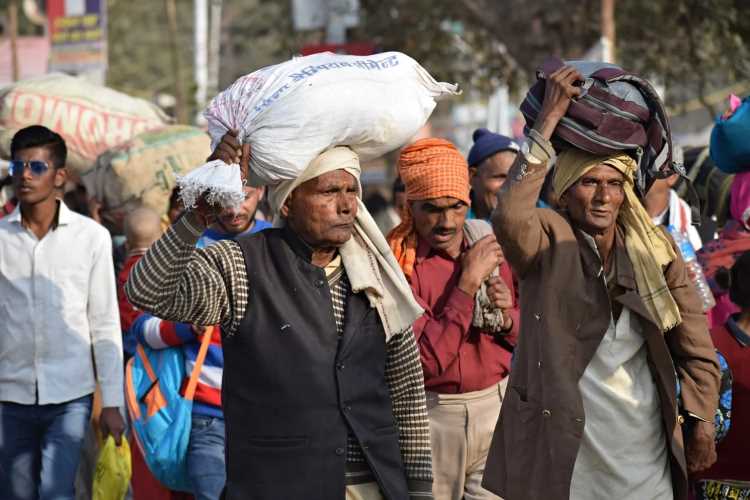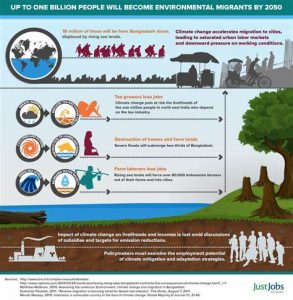
Migration is as natural to humanity as is our curiosity of what lies beyond. Historically, colonisation, war, and economic interests became the main drivers of migration. However, the trends and patterns of human migration have changed. Climate-induced migration, ‘climigration’ is set to become a key driver of migration in future. The IPCC’s 6th Assessment Report titled ‘Climate Change 2022: Impacts, Adaptation and Vulnerability’ has emphasised the extreme nature of the relationship between extreme weather events and involuntary displacement and migration. It has been projected that within the next 15 years, more people will be migrating due to climate related reasons than ever before.
Increased climate variability and extreme weather events are already driving migration It is projected that long-term climate change will increase migration flows across Asia. One in three migrants comes from Asia and the highest ratio of outward migration is seen from hazard-exposed Pacific countries.
In 2019, Bangladesh, China, India, and the Philippines each recorded more than 4 million disaster displacement. The IPCC report highlights how climate-induced migration will be a major policy aspect in the rural-urban nexus, particularly in South Asia, Sub Saharan Africa and Latin America. Given the pace of climate change and India’s susceptibility to disasters, climate change will become a pertinent factor for migration in future.
READ I Vicious circle: Global warming increases methane emissions, says study
Natural disasters and climate-induced migration
Data from the Internal Displacement Monitoring Centre (IDMC) has illustrated that in 2020 alone, over 38,56,000 people were displaced by environmental disasters in India. The recent State of the Global Climate Report 2021, released by the World Meteorological Organisation (WMO) has highlighted that carbon dioxide (Co2) in the atmosphere is 149% of the pre industrial levels.

Ocean heating and acidification, and sea level rise have major implications for millions of coastal dwellers. In addition, the vulnerability and the frequency of tropical cyclones, particularly on the western coast, is set to increase rapidly due to global warming. At the same time, India-specific findings on droughts indicate that the Deccan region is most prone to severe droughts (at least once every three years) that has led to desertification.
Not only has this caused large-scale migration from the region, but it has also resulted in overdependence on ground water resources in cities like Mumbai and Pune where groundwater extraction has doubled since 2010. Extreme weather events thus have spillover effects in neighbouring regions. Indian cities are more vulnerable than ever before. The municipal administration has to account for the existing natural resources available for the city while ensuring that environmental stressors do not aggravate existing problems.
READ I Climate change: India faces credit downgrades for slow global warming steps
Internal and external migration
Reports indicate the way in which climate change causes two types of displacements in the subcontinent — internal migration and immigration. Various events like drought, desertification, water scarcity, rising sea levels, and low food productivity have triggered migration historically. High intensity rainfalls of short durations have led to repeated flooding in Peninsular Indian states like Andhra Pradesh, Karnataka, Tamil Nadu, and Kerala.
Peninsular India recorded 143% excess rainfall in November flooding. Repeated flooding in Assam has displaced lakhs of people over the years. Prevailing drought conditions in the Marathwada and Vidarbha regions have led to increased migration to Mumbai (Business Standard 2016).
India faces a two-pronged challenge due to climate induced migration. One, which stems from climate refugees entering India from neighbouring states like Bangladesh, and the second, the increased migration within India. While migration in India is primarily agrarian in nature, it is reinforced by changing climate conditions such as droughts, changes in the weather patterns, and extreme weather events like intense rainfall leading to flooding. India has a large number of people facing prolonged displacement who are not able to return to their homes after climate hazards.
The low-lying Sunderban delta is reeling under regular floods and incidents of salt-water intrusions. The Mousuni and Ghoramara islands are among the worst affected. In addition, Kalabagi, in Khulna district of Bangladesh is home to hanging villages where agricultural lands have been washed away and residents stay in stilt houses.
Bangladesh is among the most vulnerable and worst impacted by climate change. Flash floods, and riverbank erosion are putting the livelihoods of millions at risk. It has been estimated that in south Bangladesh, sea level rise can displace 0.9-2.1 million people by direct inundation by 2050. Thus, there could be an increased flow of migrants from neighbouring countries like Bangladesh.
With a rise in extreme events world over, it is essential to develop a conceptual framework of identifying climate refugees. Thus, it is pivotal to develop social policies and provide adequate safety nets to protect the lives and livelihoods of the communities. There is a need to combine different policy instruments to support and protect the vulnerable communities in future.
Human rights protection needs to be incorporated into the planning and implementation of policies related to migration. This will help in effective and planned relocation of internally displaced communities and in turn help in easier adaptation to climate change.
Land use planning and a strategic planning framework can help communities tide over climigration. Stakeholder engagements, community consultation, mediations are key initiatives to provide necessary support — infrastructure development, temporary housing and communication channels. The dynamic nature of the environment means that existing silos must be broken down. There is a need to combine different policy instruments to support protection, adaptation and migration. This paves the way for including professional inputs from engineering, disaster management and social psychology.
At the international level, the potential of existing organisations and laws must be leveraged to account for climate-induced migration. Social schemes and national laws must strive to provide climate refugees a chance to reclaim their dignity, life and livelihood.
(Srilakshmi Nambiar is a public policy professional based in New Delhi. She is working as a Project Executive at National Productivity Council.)
